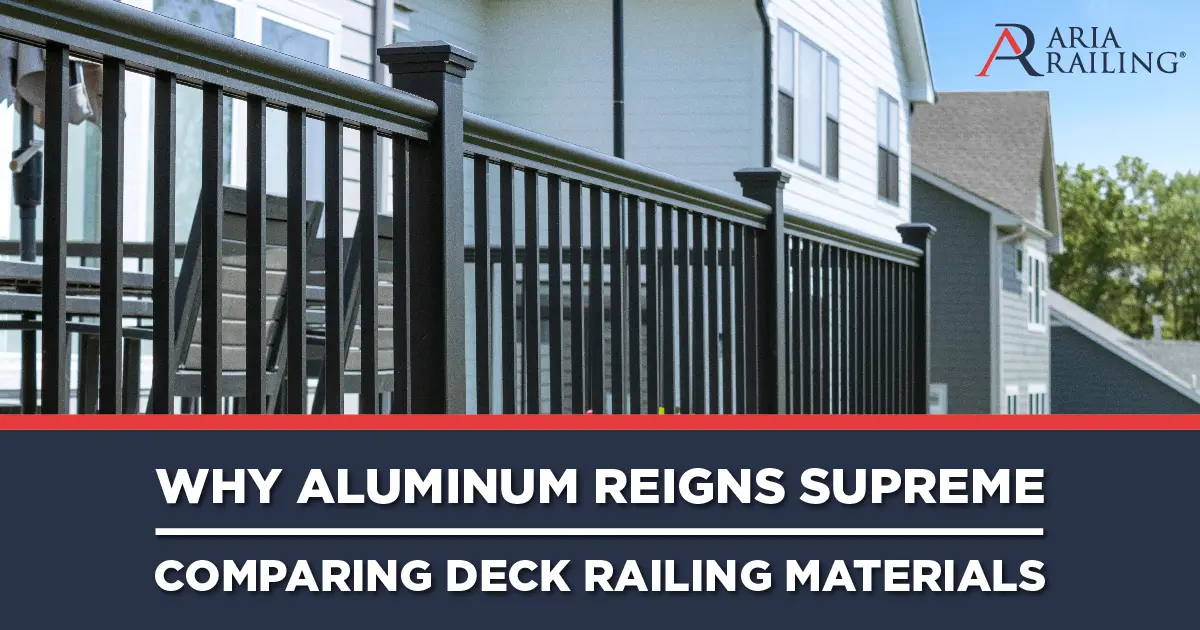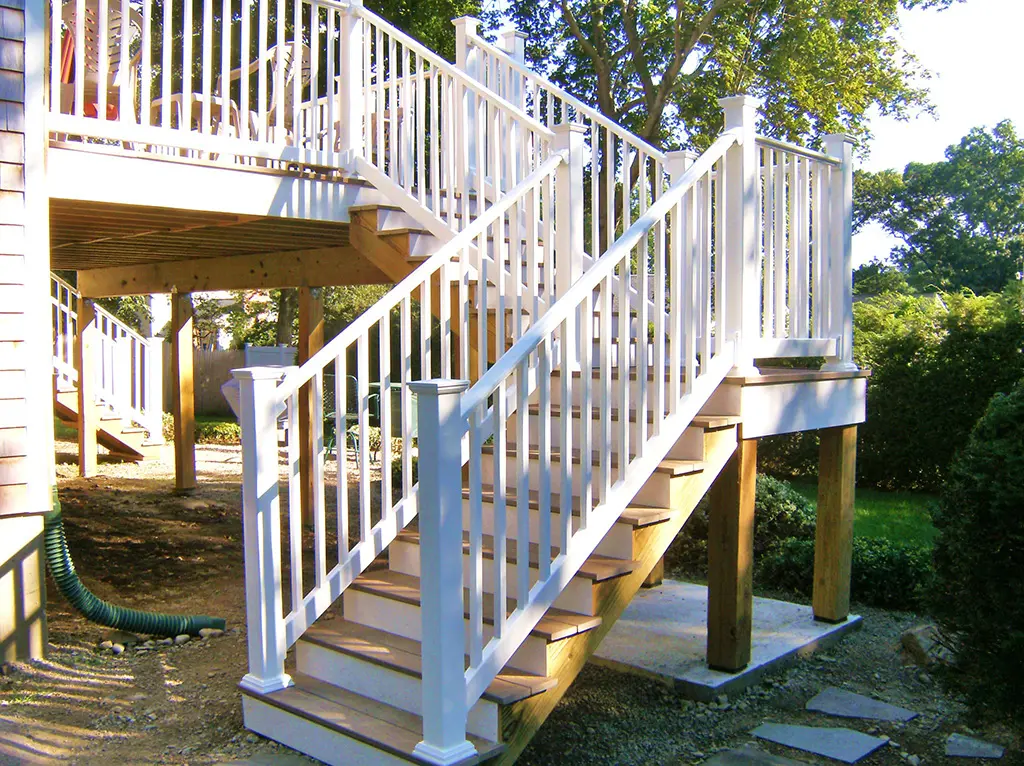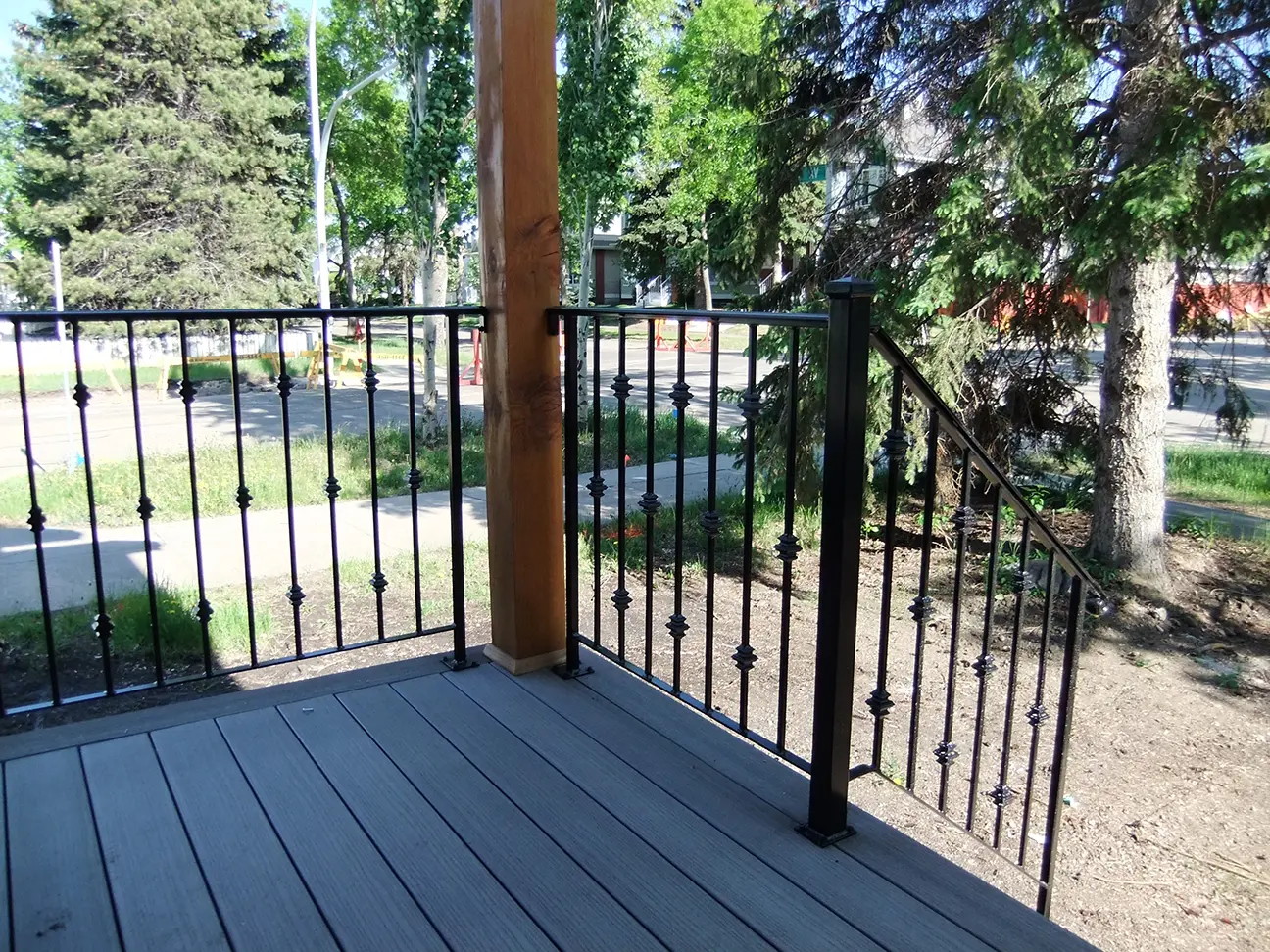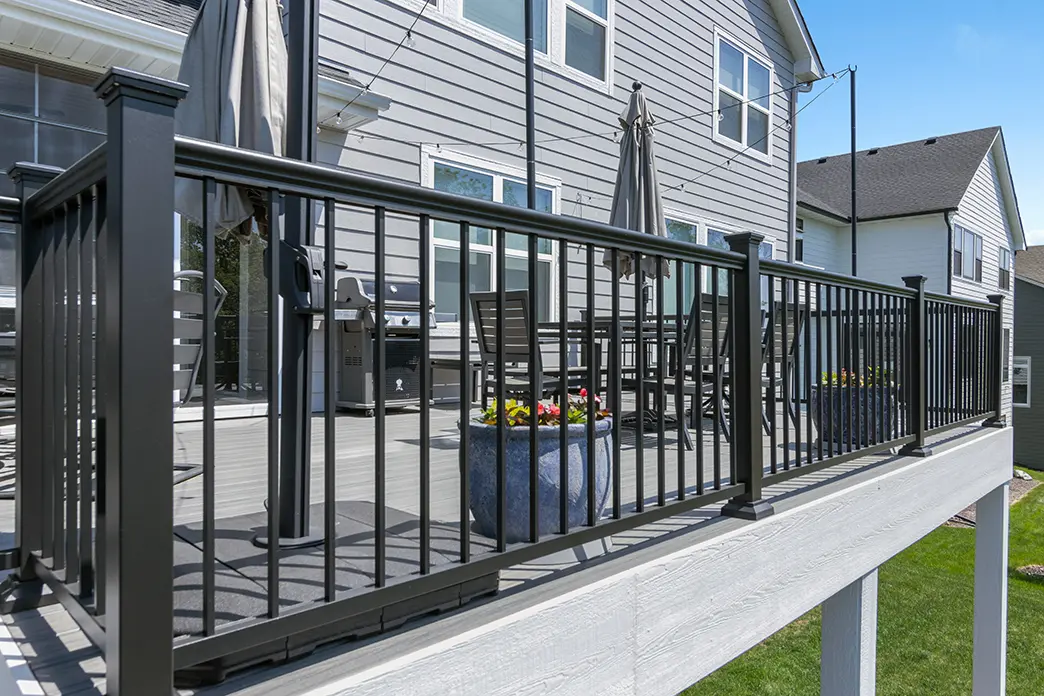
Embarking on a journey to enhance your outdoor living space with a stunning deck railing involves crucial decisions. We'll navigate through comparisons with wood, vinyl, and steel, exploring the cost, durability, maintenance, and the ease of installation.
By the end, you'll be equipped with the knowledge needed to make an informed decision tailored to your preferences and project needs. Join us as we unravel the various benefits of aluminum deck railings in the world of deck railing materials, setting the stage for a transformation that not only makes your outdoor space look great, but also stands the test of time.

Aluminum vs. Wood
Cost:
Aluminum deck railing systems, while initially pricier, prove worth it in the long run because of its lower material and installation costs. On the other hand, wood railings may be more affordable to start, but their long-term cost is increased by the amount of maintenance they need.
Taking care of wood over time can be expensive. This includes tasks like staining, sealing, and fixing. These costs can outweigh the initial savings of using cheaper wood.
Durability:
Aluminum railings are a robust choice for durability, showcasing resistance to corrosion, rust, and decay. The minimal maintenance they demand further accentuates their longevity.
In contrast, wood railings, while possessing a natural aesthetic charm, are more susceptible to the forces of nature. Vulnerable to rot, insects, and warping, wood requires consistent upkeep for sustained longevity. Regular tasks such as sealing and staining are imperative to shield wood from the elements, making maintenance a crucial factor in preserving the product over time.
Maintenance Required:
When considering maintenance, aluminum railings present a hassle-free option, demanding minimal attention. You typically only need to clean them occasionally to keep them looking pristine in your outdoor living space.
In comparison, wood railings lean towards being more high-maintenance. To uphold both their aesthetic appeal and structural integrity, regular staining, sealing, and repairs become essential. Wood railings require more time, effort, dedication, and money to maintain compared to aluminum railings, which are easier to manage.
Ease of Installation:
In terms of installation, aluminum railings emerge as a practical choice for both contractors and DIYers, characterized by their lightweight nature and the convenience of pre-assembled sections. This not only simplifies the installation process but also contributes to a quicker and more efficient setup.
On the flip side, wood railings, though admired for their natural charm, pose a heavier and potentially more intricate installation. Especially when opting for custom designs, the weight of wood and the intricacies involved may demand a more nuanced and time-consuming installation process. The ease and speed of installation become pivotal factors when deciding between the streamlined efficiency of aluminum and the potential complexities associated with wood railings.

Aluminum vs. Vinyl:
Cost:
When considering cost, the choice between aluminum and vinyl railings hinges on various factors. Aluminum may come with a slightly higher price tag than vinyl, but the overall cost fluctuates depending on design intricacies. On the other hand, vinyl railings present a generally more budget-friendly option, particularly for standard designs. The decision between the two materials involves balancing upfront expenses with the desired design and quality, allowing for flexibility in meeting both budgetary constraints and aesthetic preferences.
Durability:
In terms of resilience, both aluminum and vinyl railings showcase commendable resistance to various environmental challenges. Aluminum stands strong against weather elements, rust, and fading, ensuring a lasting and vibrant appearance. Similarly, vinyl railings prove resistant to rot, insects, and fading, offering durability in the face of different pressures.
However, it's important to note that vinyl, while generally robust, can become brittle and prone to cracking over time in extreme temperatures. This factor adds a nuanced consideration, particularly in regions with harsh climatic conditions, where the long-term performance of vinyl railings might be influenced by temperature extremes.
Maintenance Required:
When it comes to maintenance, both aluminum and vinyl railings share a commendable trait of being low-maintenance options. Aluminum requires minimal attention, with occasional cleaning proving sufficient to keep it in pristine condition. Similarly, vinyl railings are characterized by their low maintenance needs, typically requiring only regular cleaning for upkeep. The simplicity of maintenance for both materials adds to their appeal, offering users the convenience of enjoying durable and aesthetically pleasing railings without the burden of extensive and frequent care routines.
Ease of Installation:
When evaluating the installation dynamics of aluminum and vinyl railings, both materials offer convenient solutions. Aluminum, renowned for its lightweight properties and structural integrity, is often preferred for its ease of installation. Additionally, the availability of pre-assembled panels further streamlines the process, making it straightforward and efficient.
Similarly, vinyl railings, also lightweight, commonly come in pre-assembled railing kits and panels, contributing to a hassle-free installation experience. The decision between the two materials encompasses considerations of weight, structural features, and the convenience offered by pre-assembled components, allowing users to choose an installation method that aligns seamlessly with their preferences and project requirements.

Aluminum vs. Steel:
Cost:
When comparing aluminum and steel railings, cost emerges as a significant factor influencing the decision-making process. Aluminum, proving to be a more budget-friendly option, takes into account both material and installation costs. Its affordability makes it an attractive choice for those mindful of their budget constraints.
Conversely, steel railings can lean towards the pricier side, primarily due to the higher cost of materials and the potential requirement for specialized installation. The investment in steel extends beyond the initial purchase, encompassing considerations of both material quality and the expertise needed for proper installation.
Durability:
In the realm of durability, aluminum and steel railings each present unique considerations. Aluminum has the advantage of corrosion resistance, ensuring a prolonged lifespan with minimal susceptibility to environmental wear. On the other hand, while steel stands out for its inherent strength and durability, it does carry the risk of rust over time. To mitigate this, steel railings may necessitate protective coatings to maintain their structural integrity and aesthetic appeal in the face of potential corrosion.
Maintenance Required:
The maintenance considerations for aluminum and steel railings unveil distinct approaches to long-term care. Aluminum, with its innate resistance to corrosion and rust, generally demands low maintenance, a quality that can be further enhanced with the application of a protective finish. This finish acts as an added layer of defense, ensuring the railing's durability over time.
On the contrary, steel railings necessitate more meticulous care to prevent degradation. Regular maintenance rituals, such as painting and anti-corrosion treatments, become imperative to shield steel from the corrosive effects of the environment. The choice between the two materials not only hinges on their initial characteristics but also on the preferred level of maintenance commitment, with aluminum offering a low-maintenance option and steel demanding more dedicated care to preserve its longevity.
Ease of Installation:
The installation dynamics of aluminum and steel railings diverge, primarily due to their contrasting weights and structural characteristics. Aluminum, renowned for its lightweight composition, generally facilitates an easier installation process. The reduced weight makes handling and positioning more manageable, often requiring less effort and equipment.
On the other hand, steel railings, being heavier, introduce complexities that may necessitate specialized installation techniques and equipment. The decision between aluminum and steel takes into account not only the aesthetic and functional preferences but also the practical aspects of installation, with aluminum offering a more straightforward and potentially less resource-intensive setup compared to the heavier and more intricate requirements associated with steel railings.

Conclusion
In summary, aluminum railings are a top choice for both homes and businesses, despite the initial higher cost. Their long-term value is clear, thanks to robust durability, resistance to corrosion, rust, and decay, ensuring a lasting life with minimal upkeep, especially with Aria’s powder coated aluminum railings. Maintenance is a breeze, requiring only occasional cleaning. Plus, lightweight design and pre-assembled sections make installation easy for both professionals and DIY enthusiasts. A great example of this is the Aluminum Baluster Railing provided by Aria Railing. Overall, aluminum railings offer a smart investment, combining durability, low maintenance, and easy installation for attractive and reliable outdoor spaces. For a more in-depth look at the benefits and drawbacks of each deck material, check out Navigating the Deckscape: Exploring Deck Railing Material Options.
